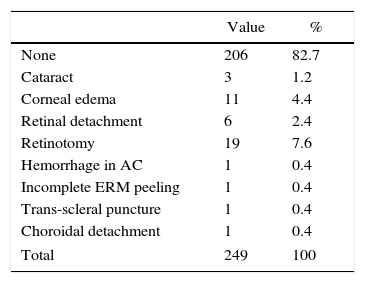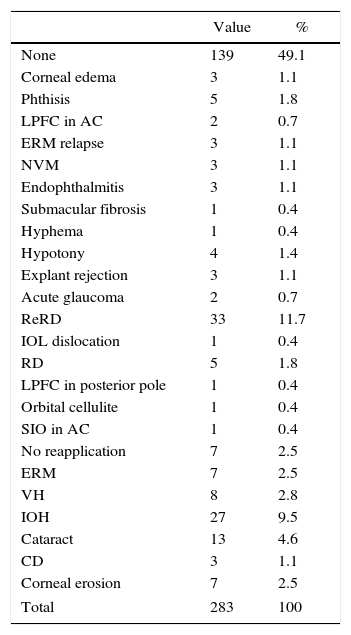To describe intra- and post-operative complications, as well as the evolution of the surgical technique in first 4years of work of a novice retina surgeon, and evaluate minimal learning time required to reduce its complications, deciding which pathologies should still be referred to higher level hospitals, until further experience may be achieved.
MethodsA study was conducted on patients that had undergone vitreoretinal surgery by a novice surgeon in Tarragona between 23rd October 2007 and 31st December 2011. The primary diagnosis, surgeon learning time, surgical technique, intra-operative and post-operative complications were recorded.
ResultsA total of 247 surgeries were studied. The percentage of use of 20G and 23G calibers during the time, marks a change toward trans-conjunctival surgery from the ninth trimester (98 surgeries). Surgical complications decreased toward twelfth trimester (130 surgeries) with an increase in the previous months.
ConclusionsThe shift toward 23G technique around 100 surgeries is interpreted as greater comfort and safety by the surgeon. Increased surgical complications during the following months until its decline around 130 surgeries can be interpreted as an ‘overconfidence’. It is arguable that the learning curve is slower than what the surgeon believes. An individual analysis of the complications and surgical outcomes is recommended to ascertain the status of the learning curve.
Describir la evolución de las complicaciones intraoperatorias y postoperatorias, así como la evolución en la técnica quirúrgica, en los 4 primeros años de un cirujano de retina y poder evaluar el tiempo de aprendizaje necesario para reducir el número de complicaciones, objetivando aquellas patologías que debieran seguir derivándose a otros centros hasta conseguir una mayor experiencia quirúrgica.
MétodosSe revisaron los pacientes intervenidos de cirugía retiniana por un cirujano novel en Tarragona, entre el 23 de octubre de 2007 y el 31 de diciembre de 2011. Se evaluaron el diagnóstico principal, el tiempo de aprendizaje del cirujano, la técnica quirúrgica, las complicaciones intraoperatorias y las postoperatorias.
ResultadosSe revisaron 247 cirugías. El porcentaje de uso de los calibers 20G y 23G durante el tiempo denota un cambio hacia la cirugía transconjuntival a partir del noveno trimestre (98 cirugías realizadas). Las complicaciones descienden a partir del trimestre 12 (130 cirugías), con un incremento en los meses anteriores.
ConclusionesEl cambio de tendencia hacia la técnica 23G alrededor de las 100 cirugías se interpreta como una mayor comodidad y seguridad en la cirugía. El aumento de complicaciones quirúrgicas durante los meses siguientes hasta el descenso a partir de las 130 cirugías se puede interpretar como un «exceso de confianza». Puede afirmarse que la curva de aprendizaje es más lenta de lo que el cirujano cree, siendo recomendable el análisis individual de las propias complicaciones y de la evolución quirúrgica para poder determinar en qué situación de la curva de aprendizaje se encuentra.
Artículo
Comprando el artículo el PDF del mismo podrá ser descargado
Precio 19,34 €
Comprar ahora













